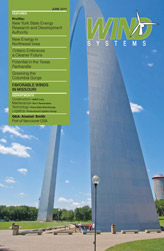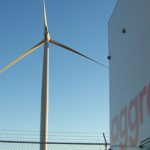Missouri may not be the first place you think of for wind energy, but turbines are skirting the highways and farmland as the state builds its case for farming wind: geographic location, green energy legislation, highly skilled workers, and a business-friendly environment. Missouri is poised to help address the planet’s ongoing need for clean, sustainable energy.
Wind energy is gaining prominence in the state, thanks in part to Missouri’s proximity to the U.S. Wind Corridor and original equipment manufacturers (OEMs). Missouri’s wind speed is 10.0 mph, higher than Texas, Colorado, Ohio, and California—states that normally jump to the top of mind (and lists) as being wind friendly. In terms of wind generation, four of the top 20 states for existing capacity are Missouri’s neighbors: Oklahoma, Kansas, Iowa, and Nebraska. Along with Missouri, these states have a combined existing capacity of 8,976 megawatts, or more than 22 percent of the current national wind power capacity. Figure 1
According to Gary Stacey, Ph.D.—director of the Center for Sustainable Energy in Columbia, Missouri—“The state has tremendous potential to build on the northwest corner. Our geographical location makes us close enough to be a player. We can also provide resources and building materials for the industry. We have major utilities that project into other states in wind energy.”
Another factor leading to increased production and use of wind as an energy source is Missouri’s Clean Energy Initiative. Adopted in 2008, the initiative requires utility companies to increase usage of renewable energy to 15 percent by 2021, using wind energy as one possible source. But it takes more than location and legislation to make the state a player in green energy technologies. It also takes a business-friendly and manufacturing-focused environment. Missouri fits the bill on both counts with a strong manufacturing base and low business costs. A highly skilled, specifically trained workforce and plentiful training centers generate a steady stream of engineers, machinists, and millwrights to feed the industry. Missouri has all the elements needed to lead future interests in clean energy.
Healthy Infrastructure
Missouri’s business climate is ideal for wind energy, in many respects. Tax credits are in place for companies that draw part of their energy from wind. Missouri businesses also enjoy the fifth lowest corporate income tax index in the United States and the fifth lowest business costs, making the state attractive to business in general and manufacturing in particular. Manufacturing has long been a mainstay of Missouri business. According to the Bureau of Labor Statistics, nearly 250,000 Missourians are currently employed in the field, making the state’s manufacturing workforce one of the largest in the Midwest.
“Missouri has a track record of successful wind farm development with broad community support,” according to Joe Gillman, acting director of the Missouri Department of Natural Resources’ Division of Energy. “We are seeing tremendous interest in this market. Wind farms create a variety of jobs ranging from construction to manufacturing, and they promote economic growth in rural Missouri.”
And at a time when much of the country is anticipating labor shortages, Missouri has workers in good supply. The state’s workforce of 3 million is actually greater than the entire populations of 20 other states, and this workforce is up to the challenges of the renewable sector. State institutes of education awarded more than 1,800 engineering degrees in 2009, with the majority of them in mechanical and electrical engineering. Figure 2
The state of Missouri is dedicated to keeping the best and brightest in the state for tomorrow’s alternative energy projects. The “Show Me JOBS” program, which qualifies employers for tax credits for pre-employment training, assures the workforce businesses will need in the future.
Specialized programs at Missouri schools are also paving the way for future projects. The Energy Research and Development Center at the University of Science and Technology in Rolla—also known as Missouri S&T—is involved in grid stabilization and storage for green energy technologies, while the Center for Sustainable Energy on the campus of the University of Missouri-Columbia coordinates research, education, and commercialization for all renewables. Washington University in St. Louis has the country’s only department of Energy, Environmental, and Chemical Engineering, and it is also home to the International Center for Advanced Renewable Energy and Sustainability (I-CARES); a center founded in 2007 to foster research on energy, environment, and sustainability across several disciplines through collaborations with the international business community. Finally, Crowder College in Neosho is home to the Missouri Alternative and Renewable Energy Technology (MARET) Center, recognized internationally for its contributions to the energy field. Crowder also offers an associate degree in alternative energy.
Green Business
Leaders in the global wind energy industry have caught the updraft of Missouri’s green enterprise. In July 2010 Iberdrola Renewables established the state’s newest and largest commercial-scale wind farm, the Farmers City Wind Power Project in Tarkio, which produces enough homegrown energy to power 33,000 average size homes a year. Wind Capital Group of St. Louis has completed four projects in the state, for a total of 163 megawatts. Through collaboration with an international partner, Wind Capital has also developed a pipeline of more than 2,000 megawatts in eight other states.
Missouri companies such as Zoltek and Emerson are key contributors to the state’s wind industry, as they provide necessary carbon fiber and control systems. In addition, Able Manufacturing, automatic technology group ABB, and other makers of wind turbine components form a growing wind energy supply chain. These companies make it possible for the state’s businesses and citizens to “go green,” but they also provide competition to foreign companies making similar clean energy hardware. Several of these companies are headquartered in Missouri. Other companies from around the world are taking advantage of Missouri’s business assets by bringing operations here. California-based Nordic Windpower—developer of the two-blade community wind turbine—and Vest-Fiber, the Danish producer of fiberglass wind turbine assemblies, both moved operations to Missouri in 2010.
The wind power pride of Missouri is Rock Port, located in the northwest corner of the state. In 2008 it became the first U.S. city to operate solely on wind energy. All the electricity for this town of 1,300 is produced by four wind turbines at Loess Hills Farm. Figure 3
A map published by the U.S. Department of Energy indicates that Missouri’s northwest has the state’s highest concentration of wind resources and contains a number of locations potentially suitable for utility-scale wind development. Local farmers and ranchers enjoy another source of income by leasing their land to local utilities. A recent green travel Web site described the town of Rock Port as follows: “This family-friendly green travel destination showcases how renewable energy makes it possible to enjoy all the modern conveniences you’ve come to expect. From the city’s street lights to the electricity running local restaurants and stores, you’ll feel at ease knowing the town’s electricity is generated from a renewable resource instead of fossil fuels.”
Winds of Change
Missouri enjoys a high quality of life, in both its small communities and major metropolitan areas such as St. Louis and Kansas City. With affordable housing, a low cost of living, quality education, and access to exceptional health care, Missouri is on the short list of businesses looking to relocate.
All the pieces of the wind energy puzzle are coming together in Missouri: proximity to the wind corridor, “green” legislative initiatives, a highly skilled and educated workforce, a supportive business environment, and an overall high quality of life. The winds of change are blowing through Missouri, and the state is acting.








































